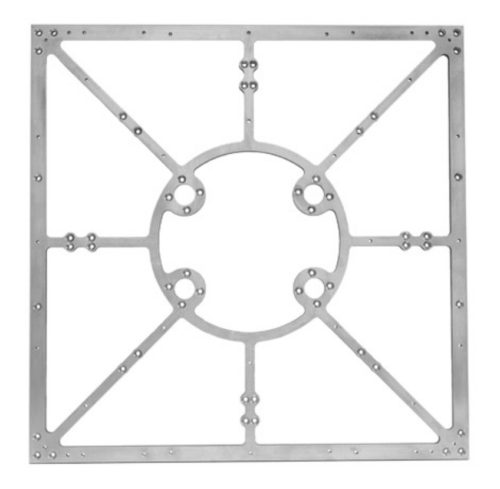When you need waterjet cutting services, Wagner Machine can deliver. Waterjet cutting is one of many capabilities we provide in-house at our Illinois machine shop.
Unlike shops specializing only in waterjet cutting services, Wagner Machine provides waterjet cutting alone or in combination with precision machining. Often, we’ll use our waterjet to cut blanks and then finish machine tighter tolerances on a CNC mill.
Many customers enlist our support when designing parts for waterjet cutting. We’re happy to discuss your design with you at any point—the earlier, the better! Here are the top Design for Manufacturing tips we commonly share with waterjet customers to ensure projects go as smoothly as possible.

DFM Best Practices for Waterjet Cutting
1. Avoid small radii on inside corners
Designing an inside radius smaller than .020” causes programming and offset issues that can slow down your project. We’ll have to convert the small radii to sharp corners to avoid cuttingerrors which is very time consuming. You can avoid this extra step by leaving inside corners sharp, or making the radius larger than .020” in your initial design.
Larger corner radii are no issue and we can cut any radius or feature you need over .020”. In fact, on inside features, larger radii cut slightly faster than small ones.
2. Design slots that are at least 2x the waterjet’s diameter
A slot measuring 0.04” or 0.05” wide is difficult to cut properly with the waterjet, which has a cutting diameter (kerf width) of 0.03”. That’s because the jet will cut full width on the first side, and will skim on the second side. The waterjet process uses the material to keep the jet focused, so it is not possible to do a skim cut properly and you will end up with a poor finish on one side of the slot.
Design slots that are at least 0.60” to avoid this issue. If you need a narrower slot, make it precisely 0.30” so the waterjet can cut it in one pass.
3. When using a soft material, plan to purchase extra
Waterjet cutting services are an excellent solution for cutting soft materials like rubber and foam that are impossible to cut using conventional machining techniques. It can cut extremely fine features with minimal setup time and no fixturing or tooling costs.
However, it’s important to note that when waterjet cutting a soft material, extra material is required.
First, we must have enough space to clamp the material in place without deforming the area we’re cutting. Second, we need to leave more space between parts on a sheet than when cutting metal or plastic. The skeleton (material between parts) is much weaker on rubber and foam, so we need more of it to keep the material stable during the cutting process.
With metal, we leave 0.150” between parts; with soft materials, we leave 0.250” – 0.500” so the skeleton of the material stays in place and the parts don’t deform.
4. Limit parts made from laminated materials to 2’ x 4’
Shops that perform waterjet cutting services exclusively may turn down projects involving laminated materials like G-10 or carbon fiber. The risk of delamination when the material is pierced on the waterjet is too high.
It requires more work, but waterjet cutting laminates can be done. Because Wagner Machine is a precision machine shop with in-house milling capabilities, we have the unique ability to take on these projects by pre-drilling start holes on a mill before moving the blank over to the waterjet.
While our waterjet can fit material measuring up to 4’ x 8’, our largest mills are limited to 2’ x 4’. So if you need us to waterjet cut laminate material, keep your part size under 2’ x 4’. If you have smaller laminated parts, we can nest them and pre-drill all the holes at the same time for higher volume production.
5. Know your clearances
The waterjet process can be used to make very accurate assemblies. To get the results you want on the first try, here are some standard clearances we recommend in different situations. A standard clearance hole for a bolt is .030” oversize. A tight fit bolt hole should be .005” – .010” oversize. We recommend no more than two tight fit holes to locate a part, but you can mix and match standard clearance and tight holes if you need more clamping force.
Press fit or slip fit holes can be reamed to the exact size you require. If you need tight tolerance holes, you can specify the tolerance or simply call out press fit and slip fit on the print. We will make the adjustments to the cut file and will ream the holes for you. We generally aim for a .0005” press fit and a .0005” – .001” slip fit.
Request a Quote for Waterjet Cutting Services
Our waterjet cutter can accommodate virtually any material you can imagine:
- Basic materials like wood, plastic, aluminum steel, stainless steel, and tool steel
- Exotic materials like hardened steels, tungsten, molybdenum, carbide, Inconel, Hastelloy, Invar, Monel, and Kovar
- Soft materials like rubber and foam
- Brittle materials like glass, ceramic, and composites
Because waterjet cutting is quicker and easier to set up than conventional manufacturing methods, we’ve been known to turn around waterjet parts in just one day. Request a quote!
